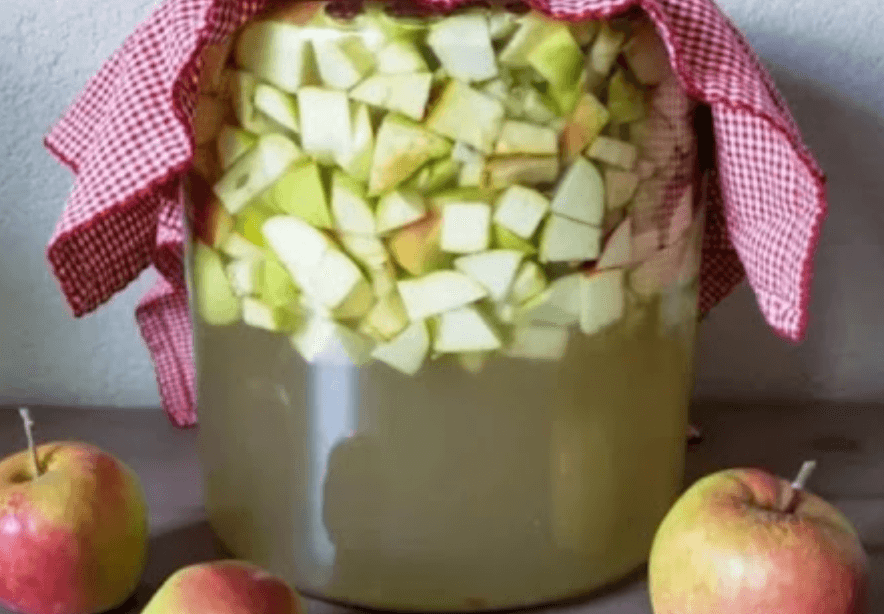Homemade apple cider vinegar (ACV) is a natural and healthy alternative to store-bought versions. It’s easy to make with just a few ingredients and can be used in a variety of ways, from cooking to cleaning. In this blog post, we’ll walk you through the ingredients, instructions, and tips for making the perfect homemade apple cider vinegar. Additionally, we’ll provide variations and address frequently asked questions to ensure you achieve the best results.
Ingredients
For the Homemade Apple Cider Vinegar:
- Apple scraps (cores and peels) from 6-8 apples, or 3-4 whole apples cut into chunks
- 2 tablespoons of sugar
- Water (filtered or non-chlorinated)
Instructions
Step 1: Prepare the Apples
- Gather Apple Scraps: Collect the apple cores and peels from 6-8 apples. Alternatively, cut 3-4 whole apples into chunks. Ensure that the apples are free from mold and rot.
- Clean the Apples: Rinse the apple scraps or chunks thoroughly to remove any dirt or pesticides.
Step 2: Start the Fermentation Process
- Fill the Jar: Place the apple scraps or chunks into a clean, wide-mouthed glass jar.
- Add Sugar: Sprinkle 2 tablespoons of sugar over the apples. The sugar helps to kickstart the fermentation process.
- Add Water: Pour enough filtered water into the jar to fully submerge the apple scraps. Leave some space at the top to allow for expansion during fermentation.
- Stir: Use a clean spoon or stir stick to mix the contents well, ensuring the sugar is dissolved.
Step 3: Cover and Ferment
- Cover the Jar: Cover the jar with a cheesecloth, coffee filter, or a paper towel, and secure it with a rubber band. This allows the mixture to breathe while keeping out insects and debris.
- Store in a Dark Place: Place the jar in a dark, room-temperature spot, such as a pantry or cupboard, for about 3-4 weeks. Stir the mixture every few days to help prevent mold from forming on the surface.
Step 4: Strain and Continue Fermenting
- Strain the Liquid: After 3-4 weeks, strain the liquid through a fine mesh strainer or cheesecloth into a clean glass jar. Discard the apple solids.
- Cover and Store Again: Cover the jar with a fresh piece of cheesecloth, coffee filter, or paper towel, and secure it with a rubber band. Store the jar in a dark, room-temperature place for another 3-4 weeks to allow the vinegar to fully develop its flavor.
Step 5: Bottle and Store
- Taste Test: After 3-4 weeks, taste the vinegar. If it has reached your desired acidity and flavor, it is ready to be bottled. If not, allow it to ferment for another week or two.
- Bottle the Vinegar: Once the vinegar is ready, transfer it to clean glass bottles or jars with airtight lids.
- Store: Store the homemade apple cider vinegar in a cool, dark place. It will continue to mature and develop more complex flavors over time.
Cooking Notes and Variations
Cooking Notes
- Use Non-Chlorinated Water: Chlorinated water can inhibit the fermentation process. Use filtered or distilled water for best results.
- Stir Regularly: Stirring the mixture regularly helps to prevent mold from forming and ensures even fermentation.
Variations
- Spiced Apple Cider Vinegar: Add a cinnamon stick, a few cloves, or a piece of ginger to the jar during the fermentation process for a spiced flavor.
- Fruit-Infused Vinegar: Add other fruit scraps like pear or peach for a unique twist on traditional apple cider vinegar.
Frequently Asked Questions (FAQs)
Q1: How do I know if my vinegar has gone bad?
A: If your vinegar develops mold, smells off, or has an unusual color, it is best to discard it and start over. Proper sanitation and regular stirring can help prevent spoilage.
Q2: Can I use any type of apple?
A: Yes, you can use any type of apple, including a mix of varieties. Different apples may result in slightly different flavors in your vinegar.
Q3: How long does homemade apple cider vinegar last?
A: When stored in a cool, dark place, homemade apple cider vinegar can last indefinitely. Its flavor may continue to develop over time.
Q4: What can I use homemade apple cider vinegar for?
A: Homemade apple cider vinegar can be used in salad dressings, marinades, sauces, as a natural cleaning agent, or even as a health tonic when diluted with water.
Q5: Why does my vinegar have a cloudy appearance?
A: A cloudy appearance is normal and often indicates the presence of the “mother,” a beneficial colony of bacteria that aids in the fermentation process.
Making homemade apple cider vinegar is a rewarding and simple process that yields a versatile and healthy product. With just a few ingredients and some patience, you can create a delicious vinegar that can be used in a variety of ways. Follow these simple steps and tips to create your own batch of homemade apple cider vinegar. Enjoy the rich flavors and the satisfaction of making something from scratch!
Whether you’re looking to make a fresh batch for culinary uses, cleaning purposes, or health benefits, this Homemade Apple Cider Vinegar recipe is an excellent choice. Enjoy the process and the results of your homemade vinegar, and feel free to experiment with different variations to make this recipe your own.






